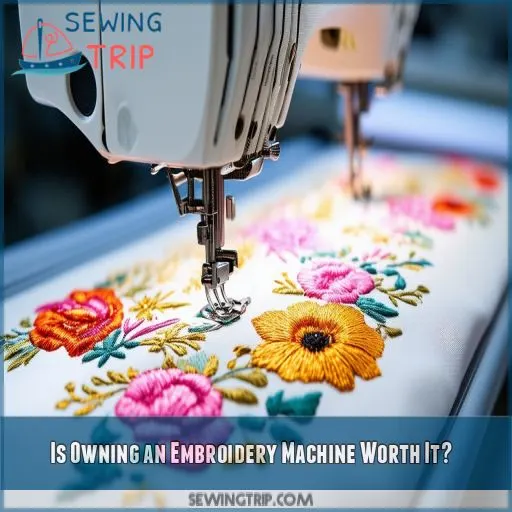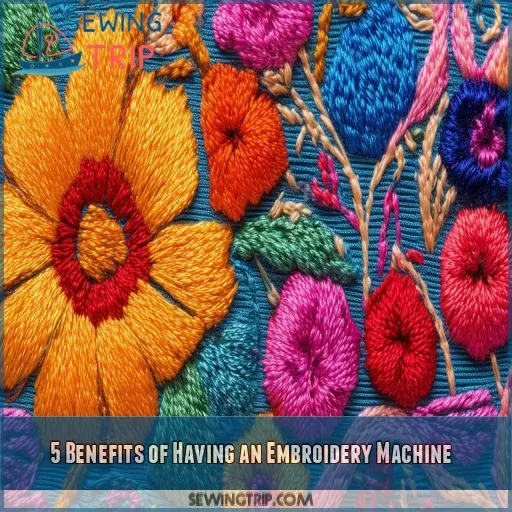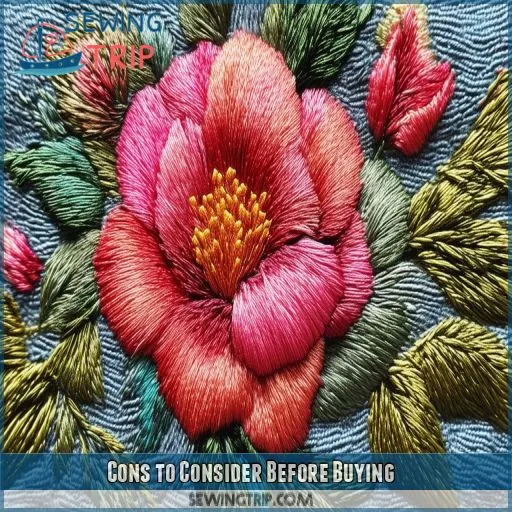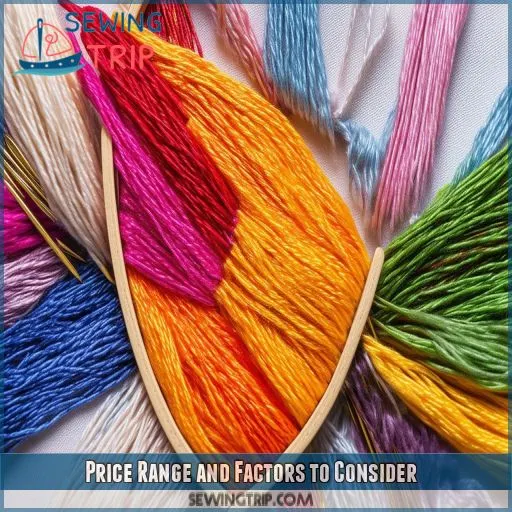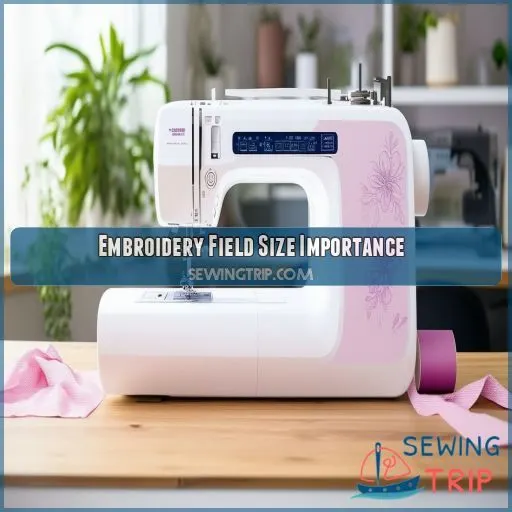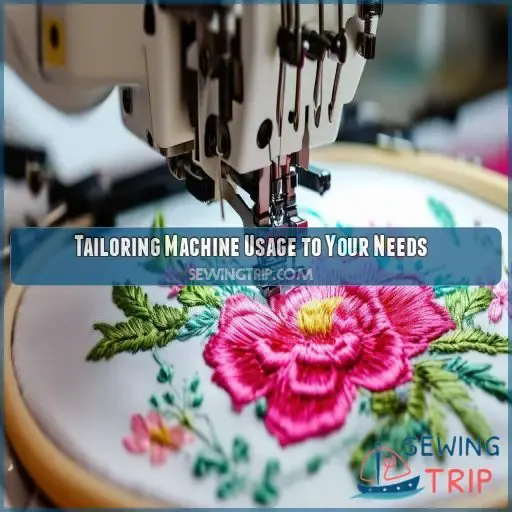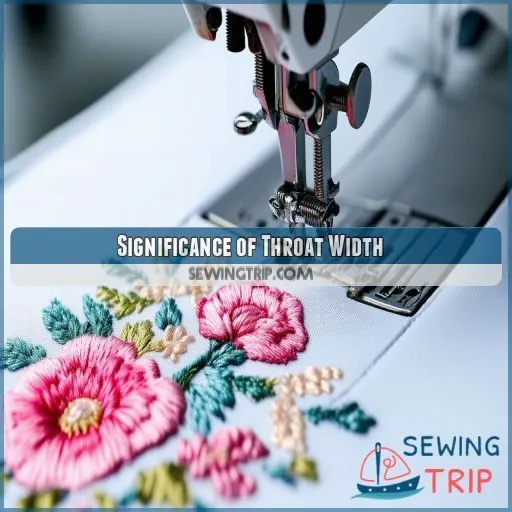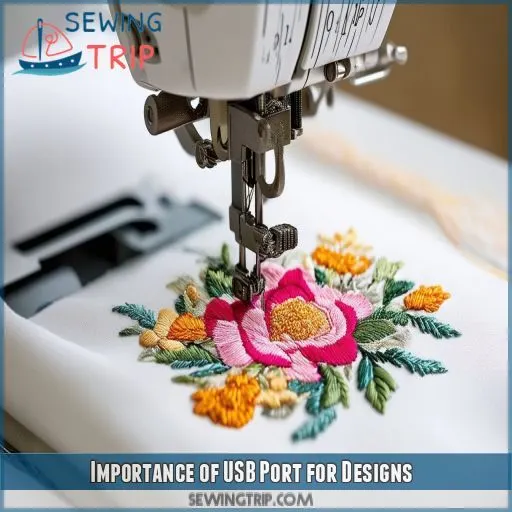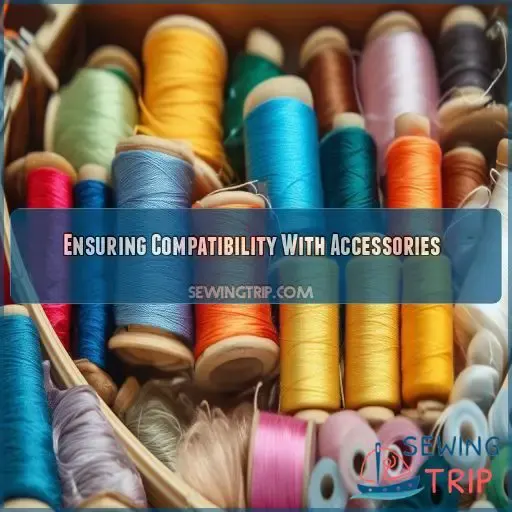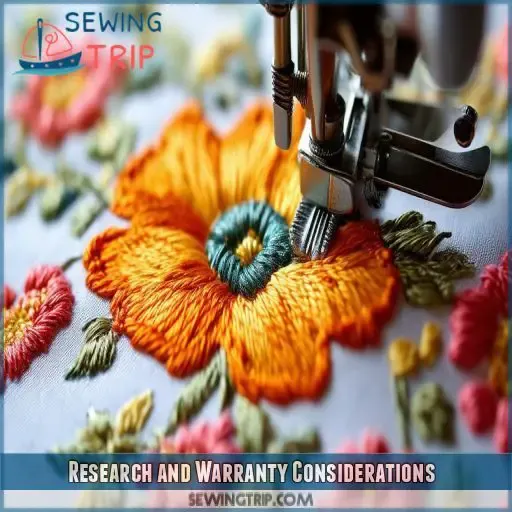This site is supported by our readers. We may earn a commission, at no cost to you, if you purchase through links.
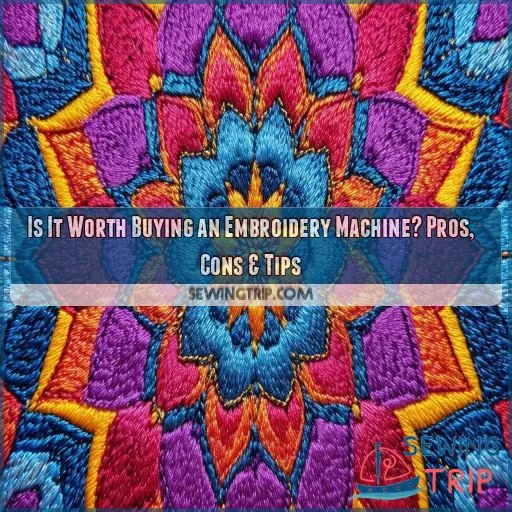
Embroidery machines offer a range of benefits, from the practical to the creative. They can be a fun way to add a personal touch to your garments and other items. But, they also come with some considerations, like the cost and the learning curve.
So, is it worth it? Let’s take a look at the pros, cons, and tips to help you decide.
Table Of Contents
- Key Takeaways
- Is It Worth Buying an Embroidery Machine?
- Is Owning an Embroidery Machine Worth It?
- 5 Benefits of Having an Embroidery Machine
- Cons to Consider Before Buying
- Price Range and Factors to Consider
- Embroidery Field Size Importance
- Tailoring Machine Usage to Your Needs
- Significance of Throat Width
- Importance of USB Port for Designs
- Ensuring Compatibility With Accessories
- Research and Warranty Considerations
- Frequently Asked Questions (FAQs)
- Conclusion
Key Takeaways
Embark on a creative journey, personalizing your wardrobe and adding flair to home decor, with unique gift ideas. Weigh the pros and cons; embroidery machines are an investment, financially and time-wise. Consider your current and future needs, the size of the embroidery field, and features will impact project versatility. Explore turning your hobby into a side hustle, but remember, earning extra cash requires effort in finding customers and marketing your services.
Is It Worth Buying an Embroidery Machine?
Whether it’s worth buying an embroidery machine depends on your needs and interests.
Embroidery machines offer a fun way to express creativity and personalize projects.
However, they also come with their own set of challenges and costs.
Is Owning an Embroidery Machine Worth It?
So, is owning an embroidery machine worthwhile? Well, that depends on several factors. First, let’s discuss the advantages and disadvantages of embroidery machines in general. Embroidery machines offer many benefits, such as the ability to create intricate designs, monograms, and customized items with precision and speed. They can also save you time and money, especially if you’re outsourcing embroidery services. Additionally, they can be a source of pure enjoyment and creativity.
However, there are some drawbacks to examine. Embroidery machines can be expensive, and they often have a steep learning curve. Troubleshooting can be challenging, and the size of the machine might be a concern if you have limited space.
When evaluating an embroidery machine, it’s important to assess the quality of embroidery thread and the options for hoop attachments. The cost of digitizing software and design storage options are also factors to keep in mind. While some machines offer built-in designs, you may want to create your own, which requires additional software. Troubleshooting assistance is another aspect to explore, as embroidery machines can sometimes be finicky.
5 Benefits of Having an Embroidery Machine
Owning an embroidery machine brings pure enjoyment and happiness, allowing you to monogram and customize everything in your home. You’ll save money and time on personalized items, possibly starting a side hustle and enhancing your quilting skills along the way.
Pure Enjoyment and Happiness
An embroidery machine opens up a world of creativity and self-expression. It’s a fun, satisfying hobby that lets you explore embroidery techniques and designs, and create unique gifts and home decor.
Monogram and Customize Everything
With an embroidery machine, you can monogram and customize to your heart’s content. Whether it’s adding a personal touch to gifts or making unique creations, the customization inspiration is endless.
Save Money and Time
Apart from the fun of customizing, an embroidery machine can also save you money and time. Here’s how:
- Time Savings: No more tedious hand-stitching. Machine embroidery is faster and more efficient, especially for larger projects.
- Cost Reductions: With an embroidery machine, you can create custom designs and gifts without the expense of outsourcing.
- Project Efficiency: The right machine accessories, like a USB port for design transfer, further streamline your projects.
- DIY Gifts: Craft unique, personalized gifts for your loved ones without the time and cost of shopping.
Start a Side Hustle
An embroidery machine opens up monetization strategies. Identify your niche, target audience, and profitability projections. Consider the Brother SE400 for a versatile option.
| Embroidery Digitizing Software | Embroidery Needle |
| Embroidery Stabilizer | Embroidery Troubleshooting |
| Marketing Channels |
Enhance Quilting Skills
If you’re into quilting, an embroidery machine can elevate your abilities. Here’s how:
- Hoop sizes and fabric movement: Larger hoop sizes allow for more fabric movement, giving you the freedom to create intricate quilting designs.
- Machine compatibility: Verify your machine is compatible with quilting projects by checking the throat width—the space between the needle and the machine body. A wider throat width accommodates larger hoops and fabric movement.
- Project complexity: With an embroidery machine, you can handle more complex quilting projects, such as custom quilting designs and embroidery gifts.
- LCD screen and embroidery software: Many machines feature an LCD screen for design visualization, and some even offer embroidery software, allowing you to create custom quilting patterns.
Cons to Consider Before Buying
Before investing in an embroidery machine, carefully consider the potential drawbacks. The high price tag, steep learning curve, and ongoing troubleshooting requirements may give some buyers pause, so weigh these cons against the benefits to determine if an embroidery machine is truly worth the investment for your needs.
Price
Now, let’s address the elephant in the room: price.
Embroidery machines vary in cost, ranging from a few hundred to several thousand dollars.
For example, the Brother SE 600 starts at $605, while the Janome MB-4S is priced at $5,299.
The cost depends on the features and hoop size of the machine.
But don’t worry if the price tag seems daunting; there are financing options and payment plans available to help make your purchase more manageable.
When comparing prices, be sure to consider any hidden costs, such as monthly fees for design software or accessories, which can add up over time.
Learning Curve
Embroidery machines have a learning curve, but you can master it with practice and persistence. Here are some considerations:
- Embroidery software and design digitizing: Familiarize yourself with the software and design process. Online forums offer a wealth of tutorials and tips for mastering advanced techniques.
- Automatic thread cutting and other features: Modern machines offer convenient features like automatic thread cutting. Understanding these features will enhance your embroidery experience.
- Screen size and visualization: Opt for a machine with a larger LCD screen for better design visualization. This can make a significant difference in your overall experience.
Troubleshooting
Troubleshooting is another element to contemplate. Embroidery machines may face issues like error codes, software glitches, or thread breaks. Maintenance tips and proper hoop selection can help prevent these problems.
Size
When considering the size of an embroidery machine, it’s imperative to contemplate the hoop size and potential design constraints:
- Determine the largest hoop size you’ll require for your embroidery designs.
- Aim for a 5×7" or larger embroidery field size to accommodate more extensive designs.
- Consider a wider throat width for quilting projects, allowing for larger hoops and more fabric movement.
- Keep in mind the available space in your sewing area, as embroidery machines can be quite bulky.
Price Range and Factors to Consider
When considering an embroidery machine, you’ll need to balance price and features, taking into account your budget and the value of different brands. Understanding what you require now and in the future will guide you toward a machine that fits your financial constraints while delivering the desired capabilities.
Price & Features
When considering price and features, evaluate the cost based on your specific needs. Key factors include embroidery field size, which determines design size, and the number of needles, essential for using various thread colours without constant re-threading. Throat width is also important, especially for quilting, as it affects hoop size and fabric movement.
Budgeting
When budgeting for an embroidery machine, a careful balance between costs and benefits is imperative.
Identify your indispensable features and desires, factoring in both current and future needs.
This approach will enable effective budget allocation and provide assurance that expenses are justified, without unnecessary extravagance.
Affordability is a primary concern; therefore, remain mindful of your financial constraints and invest prudently.
Brand Value
When evaluating brand value, it’s essential to prioritize value for your investment rather than succumbing to the allure of brand recognition. Avoid overpaying simply for a renowned name. Instead, compare features and quality across various brands, and consider cost-effective options that still meet your requirements. Brand loyalty is valuable, but not at an inflated cost.
Embroidery Field Size Importance
The size of the embroidery field is a critical consideration when choosing an embroidery machine. The embroidery field, or hoop size, determines the maximum design size you can create. While a larger field increases costs, it’s worth investing in the largest size you can afford to accommodate future projects and design requirements.
For example, if you plan to embroider large designs on items like quilts or jackets, a smaller hoop size will result in an uneven and unprofessional finish. Aim for a minimum of 5×7 inches, but if your budget allows, go bigger. Embroidery machines with larger embroidery fields come at a higher cost. Remember, free designs are widely available online, and you can create custom designs with digitizing software, so don’t be limited by built-in options. Make sure your machine has USB compatibility to easily load designs.
Tailoring Machine Usage to Your Needs
Now that you’re aware of the importance of embroidery field size, it’s time to adapt the machine’s usage to your specific needs. This is a vital step to secure the maximum benefit from your investment and unleash the full potential of your creativity.
Embroidery machines offer a wide range of applications that can cater to various interests and skill levels. Whether you’re a hobbyist or an entrepreneur, there’s a world of possibilities to explore.
For instance, if you’re passionate about hobby sewing, home decorating, or gift-making, an embroidery machine can elevate your creations to the next level. Imagine personalizing quilts, curtains, or handmade gifts with intricate designs and monograms.
On the other hand, if you’re thinking of starting a small business or pursuing apparel design, an embroidery machine can be an invaluable asset. It will enable you to create unique, customized products that stand out in the market and help you build a successful enterprise.
Significance of Throat Width
Throat width, or the space between the needle and the machine body, is an important consideration, especially if you plan on quilting or working with large fabric projects. A wider throat width provides more quilting space, allowing you to maneuver larger pieces of fabric with ease. It also accommodates larger hoop sizes, giving you more flexibility in your projects.
When choosing an embroidery machine, consider the throat width in relation to the size of projects you’ll be working on. If you often tackle large fabric pieces or have specific hoop size requirements, opt for a machine with a wider throat width to guarantee compatibility and smooth fabric handling.
Importance of USB Port for Designs
The USB port is an essential feature to consider when selecting an embroidery machine. It allows for easy design loading, guaranteeing you’re not restricted to pre-installed patterns. Here’s why USB compatibility is critical:
- USB Transfer: This enables you to transfer designs from your computer to the machine using a USB stick. It’s a convenient and flexible way to load designs, avoiding the trouble of cables or outdated media.
- Design Availability: With a USB port, you open up a realm of design possibilities. Online platforms and communities offer a vast selection of free and affordable designs for download, guaranteeing you’re never short on creative options.
- Design Compatibility: By supporting USB transfers, your machine can accommodate designs from various sources. This compatibility ensures you’re not limited to specific formats or restricted design pools, giving you the freedom to explore and experiment.
When selecting an embroidery machine, prioritize those with USB stick transfer capabilities. It empowers you with design flexibility and accessibility, enhancing your creative potential.
Ensuring Compatibility With Accessories
Maintaining your embroidery machine’s seamless operation with various accessories is imperative. Here are some factors to account for:
| Factor | Description | Tips |
|---|---|---|
| Accessory Compatibility | Verify the machine’s compatibility with diverse accessories such as hoops, needles, and stabilizers. | Check for compatibility with specific brands or models to avert issues. |
| Software Compatibility | Confirm the machine’s functionality with different software programs for design creation and editing. | Seek software compatibility lists or contact the manufacturer for clarification. |
| USB Compatibility | Verify the machine’s support for USB connections to facilitate design transfer. | Avoid antiquated connection methods that limit your design options and flexibility. |
Additionally, consider design compatibility and file format support. Ensure the machine’s ability to handle various design formats to expand your creative possibilities.
Research and Warranty Considerations
When purchasing an embroidery machine, thoroughly research the features that are most important to you and your budget. Carefully compare brands to get the best value for your money, and don’t forget to account for the warranty coverage offered.
Feature Research
When researching features, consider design digitizing, hoop options, thread types, fabric suitability, and maintenance tips. For example, you’ll want a machine with a USB port for easy design loading and the ability to use various thread types and fabrics. Avoid machines with only pre-installed designs, as they limit your creativity and customization options.
Budgeting
Budgeting is an essential factor to consider when thinking about purchasing an embroidery machine.
Determine your budget and stick to it. Take into account the costs of the machine, keeping in mind that the price will depend on the embroidery field size you require.
Evaluate your financial constraints and future needs. Remember, the cost varies according to the features and hoop size of the machine.
For instance, the Brother SE 600 with a 4×4" field size is priced at $605, whereas the Janome MB-4S, offering a more spacious 9.4×7.9" field size, costs significantly more at $5,299.
Brand Comparison
When comparing brands, focus on value—don’t get caught up in name recognition. Explore affordable options with essential features like USB compatibility and software options. Test different brands to find the best fit for your needs.
- Compare features and quality across brands.
- Try out different machines to find the right fit.
- Consider affordable options with USB compatibility and software options.
- Look for value, not just brand recognition.
Frequently Asked Questions (FAQs)
Is an embroidery machine a good investment?
Whether an embroidery machine is a good investment depends on your needs and budget. On the one hand, they offer creative freedom and the potential for a side hustle. On the other hand, they can be expensive, bulky, and have a steep learning curve. Weigh the pros and cons before investing.
Is an embroidery sewing machine worth it?
It’s worth buying an embroidery machine if you plan to use it regularly and have the space for it. Embroidery machines offer endless creative possibilities for customising your clothes and other items.
Can you make money with an embroidery machine?
Yes, you can make money with an embroidery machine. It’s possible to earn $500+ per day with two machines, working on multiple jobs at once. To succeed, you must be willing to put in the work, keep your machines running, and find customers. Utilize social media for free advertising and consider investing in marketing systems to target customers.
What do I need to know before buying an embroidery machine?
First, determine your budget and must-have features. Next, consider buying a popular machine, like the Brother PE800, for easy access to online resources and support. Also, test the machine and verify it’s serviceable in your area.
Do I need a separate sewing machine?
So, you want to be a jack-of-all-trades, eh? Well, get this: some embroidery machines can only embroider. But if you want to sew and embroider, you can get a machine that does both.
Whats the ideal embroidery field size?
Go for the largest embroidery field size you can afford. It gives you more design options, like quilt blocks and clothing appliques. A standard size for embroidery depends on its intended use. For shirts, jackets, and hats, sizes range from 3 to 5 inches.
Can I connect my machine to Wi-Fi?
Yes, you can connect your embroidery machine to Wi-Fi. There are devices available that allow you to wirelessly transfer embroidery designs and files to your machine over Wi-Fi. These devices are compatible with most machines on the market.
What features are essential for beginners?
Essential features for beginners include pre-wound bobbins, embroidery needles, machine oils, and USB transfer capability. Some newer machines also use Wi-Fi design transfer.
How much does an embroidery machine cost?
Embroidery machine costs vary. Budget machines for beginners start at $250, mid-level machines cost at least $600, and high-level machines can reach $1,000 or more. Used machines are another option, with 1- or 2-head machines costing around $2,
Conclusion
If you’re looking to embroider a wide range of items, an embroidery machine might be a worthwhile investment.
You can enjoy the creative process, personalize your garments, and even save money and time.
However, consider the initial cost, the learning curve, and the size of the machine.
Ultimately, the decision to buy depends on your specific needs, budget, and the importance you place on the benefits.

